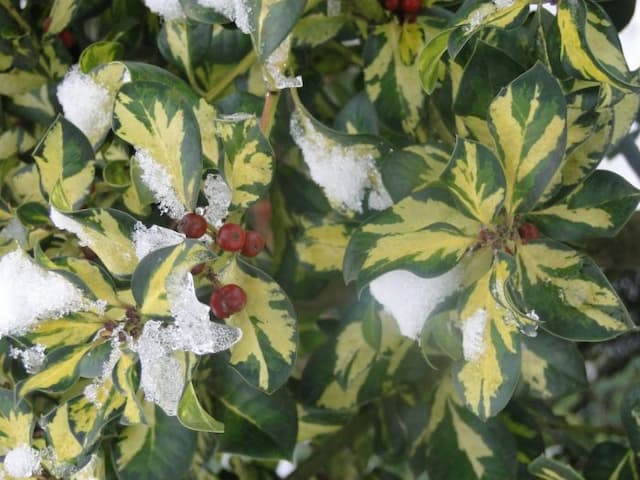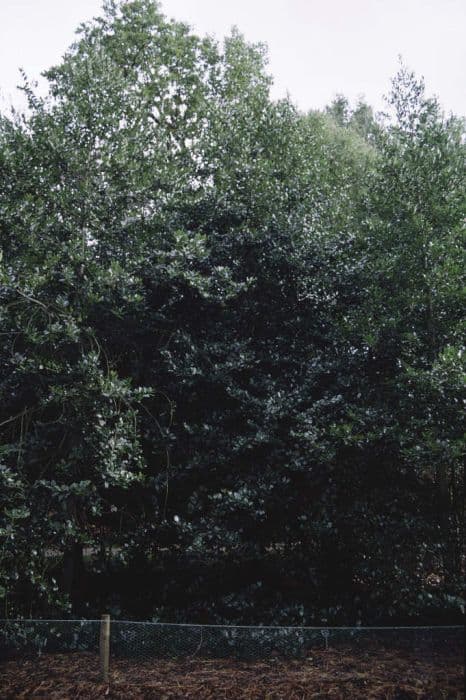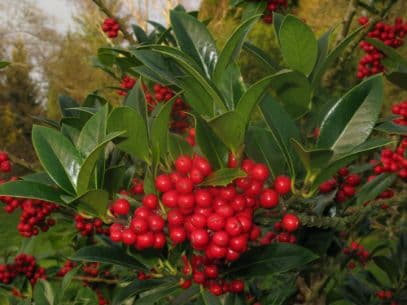Japanese Holly Ilex crenata 'Convexa' (f)

ABOUT
The Japanese holly 'Convexa' is a dense, evergreen shrub with small, glossy leaves. The leaves have a convex shape, meaning they are slightly curved or dome-shaped, and exhibit a lush green color with finely-toothed edges. Unlike some other hollies, the foliage of 'Convexa' is not prickly, making it softer to the touch. During the spring and summer, the shrub produces tiny white flowers that may be observed upon closer inspection, however, they are not particularly showy and are often overshadowed by the dense foliage. As the seasons progress, these flowers give way to small, black berries that are a source of food for birds. This plant is popular for its attractive, textured foliage and its versatility, often used in landscaping as a hedge or a foundational plant due to its tidy, mounded growth habit.
About this plant
 Names
NamesFamily
Aquifoliaceae
Synonyms
Japanese Holly, Box-leaved Holly, Convex Japanese Holly
Common names
Ilex crenata f. convexa, Ilex crenata var. convexa.
 Toxicity
ToxicityTo humans
Japanese holly, including the 'Convexa' cultivar, can be toxic if ingested. The plant contains saponins, which, when consumed in large quantities, can lead to symptoms such as nausea, vomiting, diarrhea, and stomach cramps. In some cases, if a substantial amount is ingested, it could potentially lead to more severe symptoms, but poisoning from this plant is generally uncommon and not typically life-threatening.
To pets
Japanese holly is toxic to pets, such as dogs and cats. The plant contains saponins that can cause symptoms like drooling, vomiting, diarrhea, lethargy, and abdominal pain if ingested. While the toxicity is generally considered to be of low to moderate severity, ingestion of significant amounts could lead to more serious complications and warrant immediate veterinary care.
 Characteristics
CharacteristicsLife cycle
Perennials
Foliage type
Evergreen
Color of leaves
Green
Height
5 feet (1.5 meters)
Spread
6 feet (1.8 meters)
Plant type
Shrub
Hardiness zones
5
Native area
Japan
Benefits
 General Benefits
General Benefits- Ornamental Appeal: Ilex crenata 'Convexa' is valued for its small, dark green, glossy leaves that create a dense, textured appearance.
- Flexibility in Landscaping: Commonly used in formal gardens, hedges, foundation plantings, and topiary due to its tolerant nature and ease of pruning.
- Durability: It is a hardy plant capable of withstanding cold climates, making it suitable for a variety of garden zones.
- Low Maintenance: Requires minimal care once established, needing only occasional pruning to maintain shape.
- Pest Resistance: Generally resistant to common pests and diseases, reducing the need for chemical treatments.
- Wildlife Attraction: Produces small, blackberries that provide food for birds and other wildlife.
- Year-Round Interest: Evergreen foliage provides color and texture in the garden throughout the year.
- Variety in Sizes: Available in different sizes and forms, including dwarf varieties, to suit different landscaping needs.
- Erosion Control: Can be used on slopes and banks to help prevent soil erosion thanks to its dense root system.
- Adaptability: Tolerates a range of soil types from acidic to alkaline, provided the soil is well-drained.
 Medical Properties
Medical PropertiesThis plant is not used for medical purposes.
 Air-purifying Qualities
Air-purifying QualitiesThis plant is not specifically known for air purifying qualities.
 Other Uses
Other Uses- Bonsai Cultivation: Ilex crenata 'Convexa' is popularly used for bonsai due to its small leaves and the ability to shape its dense foliage into artistic forms.
- Topiary Art: This plant can be clipped and maintained in various ornate shapes, making it suitable for decorative topiary gardens.
- Privacy Screening: When planted in a row, Japanese holly 'Convexa' can form a dense, evergreen screen, providing privacy year-round.
- Barrier Plantings: The dense growth habit of Japanese holly 'Convexa' makes it an excellent choice for creating a living fence or barrier to outline property boundaries.
- Foundation Planting: Its compact size and resistance to many plant diseases makes it a favored choice for use around home foundations, softening building lines, and providing year-round foliage.
- Wildlife Habitat: The dense branches and foliage provide cover and nesting sites for birds and other small wildlife.
- Urban Landscaping: Japanese holly 'Convexa' is suited for urban environments because it tolerates pollution and can thrive in confined soil spaces.
- Container Gardening: Its small size and slow growth rate make it an ideal candidate for growing in containers on patios, terraces, or other small spaces.
- Soil Erosion Control: When used on slopes, its root system may help stabilize soil and prevent erosion.
- Winter Garden Interest: The evergreen leaves and black berries provide visual interest to the garden during the dreary winter months when other plants have died back.
Interesting Facts
 Feng Shui
Feng ShuiThe Japanese holly is not used in Feng Shui practice.
 Zodiac Sign Compitability
Zodiac Sign CompitabilityThe Japanese holly is not used in astrology practice.
 Plant Symbolism
Plant Symbolism- Resilience: Ilex crenata 'Convexa', commonly known as Japanese holly, is known for its hardiness and ability to withstand harsh conditions, symbolizing resilience and the ability to endure tough times.
- Protection: Historically, hollies have been considered symbols of protection due to their thorny leaves, representing the idea of safeguarding oneself or one's home from negative forces.
- Good Luck: In various cultures, holly is associated with good fortune and is often used in decorations during festive seasons to invite luck into the home.
- Hope: The evergreen nature of Japanese holly, with its year-round green foliage, represents hope and the promise of new growth, even in the darkest times of the year.
 Water
WaterJapanese holly 'Convexa' prefers consistent moisture, but it's essential not to overwater. Water the plant when the top inch of soil feels dry to the touch, which generally means giving it 1 to 1.5 gallons of water every week during the growing season. In hotter, drier periods, you may need to water twice a week, while in cooler or rainy conditions, watering once every two weeks may suffice. Always check the soil moisture before watering to prevent root rot, which can occur if the soil is kept too wet.
 Light
LightJapanese holly 'Convexa' thrives best in partial to full sun. It should receive at least four hours of direct sunlight each day but can also prosper in light, dappled shade. The best spot for this plant would be one where it's protected from the intense afternoon sun, particularly in hotter climates, to prevent leaf scorch.
 Temperature
TemperatureJapanese holly 'Convexa' is hardy and can withstand a wide range of temperatures, thriving ideally between 50 to 70°F. It can survive in temperatures as low as 0°F, making it suitable for many climates. However, prolonged exposure to temperatures over 90°F can stress the plant, so providing some shade during the hottest part of the day is beneficial.
 Pruning
PruningPruning Japanese holly 'Convexa' helps maintain its shape and encourages healthy growth. Pruning should be done in the late winter or early spring before new growth starts. It's also beneficial to prune after a growth spurt in the summer to keep the desired form. Thinning cuts help improve airflow, which prevents disease, while shearing helps maintain a hedge shape.
 Cleaning
CleaningAs needed
 Soil
SoilBoxwood prefers well-draining soil with a pH of 5.5 to 6.5. A mix of 50% peat, 25% pine bark, and 25% coarse sand or perlite is ideal for good growth and root health.
 Repotting
RepottingBoxwood should be repotted every 2 to 3 years to refresh the soil and accommodate root growth, in the early spring before new growth begins.
 Humidity & Misting
Humidity & MistingBoxwood thrives in moderate humidity levels, aim for a range between 40% to 60%, avoiding extremely dry air that can damage the leaves.
 Suitable locations
Suitable locationsIndoor
Place boxwood near bright window; water sparingly.
Outdoor
Plant in partial shade; protect from harsh winds.
Hardiness zone
5-9 USDA
 Life cycle
Life cycleIlex crenata 'Convexa', commonly known as Japanese Holly, begins its life cycle when its seeds are dispersed and successfully germinate in soil with adequate moisture and light. Seedlings emerge and gradually mature into shrubs, developing glossy convex leaves and a dense, rounded habit. As it reaches juvenile stages, it may take several years to start flowering, ultimately producing small white flowers which are pollinated by insects, leading to berry production. After pollination and if conditions are favorable, the flowers transform into black drupe fruits containing seeds for the next generation. Throughout its life, Japanese Holly experiences seasonal growth cycles, with active growth in spring and summer and dormancy in winter. The plant has a long lifespan and can maintain good health for decades with proper care, including pruning to shape and control size.
 Propogation
PropogationPropogation time
Spring-Early Summer
The most popular way to propagate Japanese Holly 'Convexa' is through semi-hardwood cuttings. This method is typically done in late summer after the current season's growth has begun to harden but is not yet fully mature. To propagate, cut a 4-6 inch (10-15 cm) long stem section, removing the lower leaves to expose the nodes. Dip the cut end of the stem into rooting hormone to encourage root growth. Plant the cutting in a well-drained soil mixture, and keep it moist and in a warm environment. With proper care, the cutting should develop roots within a few weeks, at which point it can eventually be transplanted to a more permanent location.









